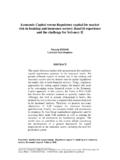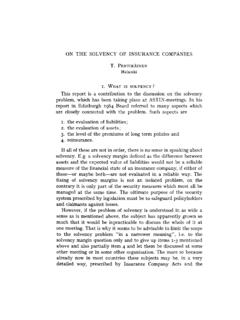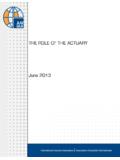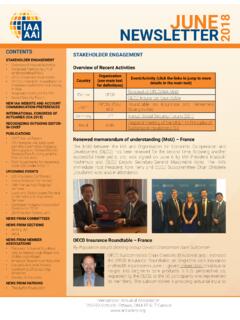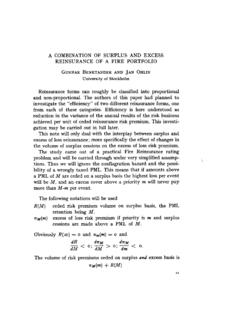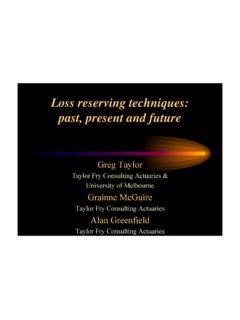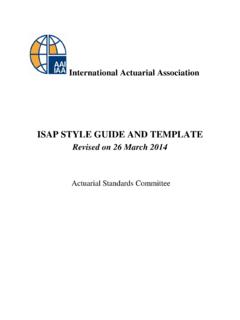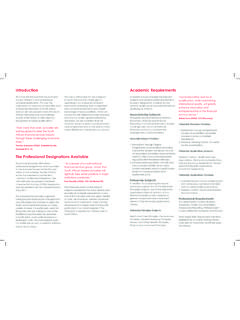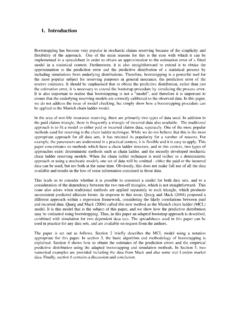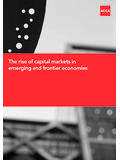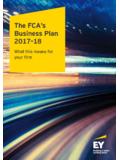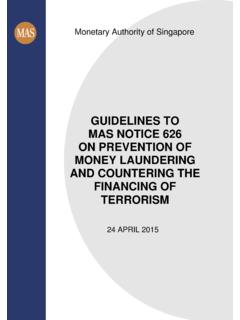Transcription of IAA Paper on Stress Testing and Scenario - HOME …
1 Stress Testing and Scenario Analysis July 2013 International Actuarial Association Association Actuarielle Internationale 150 Metcalfe Street, Suite 601 Ottawa, Ontario Canada K2P 1P1 Tel: 1-613-236-0886 Fax: 1-613-236-1386 Email: 2013 International Actuarial Association / Association Actuarielle Internationale This Paper has been produced by Insurance Regulation Committee of the IAA and has been approved by that committee. i Table of Contents Executive Summary .. 1 Introduction .. 1 Definitions .. 3 Uses of scenarios .. 7 Solvency Testing and financial condition reporting .. 7 Risk management .. 8 Analysis of non-quantifiable risks .. 9 Senior management and Board involvement ..10 Regulators and scenarios ..10 Assessment of internal models ..12 Defining the firm s risk appetite ..12 Developing scenarios ..14 Types of scenarios .
2 14 Reverse scenarios ..14 Historical scenarios ..14 Synthetic scenarios ..15 Company-specific scenarios ..16 Single event scenarios ..16 Multi-event scenarios ..16 Global scenarios ..16 Scenario / Testing governance ..17 Behavioral factors ..18 ii Time frame ..18 Interdisciplinary approach ..19 Own Risk & Solvency Assessment (ORSA) ..19 Formulation of a Scenario ..19 Narrative ..20 Initial event ..21 Time evolution ..22 Risk Dependencies ..23 Immediate Dependencies ..24 Time-lagged Dependencies ..24 Feedback ..24 Phase-Shift ..25 Evaluation of scenarios ..26 Secondary Scenario rollout over time ..27 Risk mitigation ..28 Management Actions ..28 Analysis ..31 Case study 1: Effect of possible economic scenarios ..32 Case study 2: Pandemic ..35 Case study 3: Sovereign default ..38 Conclusion and outlook ..40 Stress Testing and Scenario Analysis 1 Executive Summary This Paper provides an actuarial perspective on Scenario analysis and Stress Testing .
3 As part of the analysis of risks to the financial condition of a firm, these methods are essential tools for effective risk management and macro prudential oversight. They can enhance the understanding by its stakeholders of the financial vulnerability and viability of the firm. A Scenario describes a consistent future state of the world over time, resulting from a plausible and possibly adverse set of events or sequences of events. A Stress test provides an assessment of an extreme Scenario , usually with a severe impact on the firm, reflecting the inter-relations between its significant risks. Together, they complement the use of economic capital models that apply probabilities to possible future scenarios to determine appropriate capital needs of a firm. In contrast to internal models, Scenario analysis and Stress Testing assess the financial effect of the events or sequence of events that lead to specific scenarios in adequate detail so that their causes can be identified and their effects on the firm can be understood.
4 Thus, they can be used to enhance the understanding of if and why a firm is vulnerable to highly uncertain tail risks. A firm should recognize the value of both approaches, , economic capital models as well as Scenario analysis and Stress Testing , to capture and assess the risks and opportunities of the firm associated with specific sets of scenarios , especially where the likelihood of occurrences are highly uncertain. The results of Scenario analysis and Stress Testing , including an explicit description of particular scenarios and what might lead to them, can be clearly communicated and understood by senior managers, directors of Boards and other stakeholders. They can also be used to identify the scenarios and the type of adverse risks that would result in a given degree of financial Stress . Their use can enhance the risk culture of a firm, as they can alert decision makers to potentially inconvenient truths and provide a framework to enable firms to base their business strategies and risk mitigation activities on a range of forecasts rather than a single best-estimate projected result or an average of stochastic results.
5 Introduction The use of internal models is becoming more important for management, regulators and rating agencies in the financial services industry worldwide in order to assess the financial condition and capital needs of its participants. These models are currently used by some regulators to determine regulatory capital requirements1 and by rating agencies as a sign of competent risk management. Firms have applied their results to develop and refine their corporate strategies. 1 Reference Solvency II and Basel II for Trading Book, Canada and US RBC Stress Testing and Scenario Analysis 2 The International Actuarial Association has prepared guidance on the development and use of internal models2. They are typically used to project a firm s financial condition, which includes determining its ability to fulfill its obligations to its policyholders over a fixed future period, based on a set of assumptions about the general economy, the environment in which the firm operates and the firm s operating situation.
6 Economic assumptions are often derived from stochastic generators in an internal model using parameters based on either historical experience over a certain period of time or on current or recent conditions. The reliability of these generators depends on the underlying probability distributions chosen and on the data used to fix the parameters of the generator. Common deficiencies of such models can include a lack of sufficiently "heavy" tails in the probability distributions used (common in many of the most widely used distributions) and calibration of the distribution s parameters from a time period of insufficient length to capture a representative range of conditions. By way of contrast, another deficiency can arise when the modeler does not consider recent conditions in the baseline projections to reflect recent drivers and trends that may be more evident if recent experience is considered.
7 If the model does not appropriately consider sufficiently extreme (in the "tail" of the probability distribution) conditions that can lead to "severe" Stress to the firm, its results may not adequately capture the risks and uncertainties that may arise. Stress to the financial institution may be the result of a complex set of interactions of various risk factors (some of which may not be quantifiable). Although these interactions are often unique and difficult to predict, expected interactions of generic Stress conditions may be sufficiently embedded in an internal model to reflect an adequate range of possible futures. Even if the probability distribution used includes a heavy tail, it is unlikely that every possible stressed environment or every possible contingent event will be considered in a stochastic simulation. Needless to say, especially in light of recent crises, it is important to investigate the effect of a range of possible assumptions about the environments on the firm's financial condition and indeed its solvency and to prepare appropriate risk management strategies for possible use.
8 A limitation of stochastic methods is that since they reflect a weighted average of multiple scenarios as they focus on expected costs, preferences or prices; they do not focus attention on the effect of actual (albeit unlikely before the fact) scenarios , even though some of them represent extreme conditions with potentially disastrous results. Therefore, to study and plan for the effect of specific types of scenarios , an internal model is applied to assess the effects of the individual Scenario and the realistic mitigation approaches used in response. The study of deterministic scenarios can also be useful for other purposes, such as sensitivity Testing , development of management strategies and operational plans, product development and financial planning. In addition, regulators can specify particular scenarios to be tested by all firms operating under their authority to gauge possible impacts of systemic risks to both the system as a whole and/or to a range or type of individual firms.
9 2 IAA Note on the Use of Internal Models for Risk and Capital Management Purposes by Insurers Stress Testing and Scenario Analysis 3 This Paper discusses the considerations that may be used to help develop useful deterministic scenarios for insurance companies and other financial institutions for use in sensitivity analysis and Stress Testing . This Paper is principally concerned with the assessment and enhanced understanding of the effects of sensitivities and stresses on a financial services firm or industry through a systematic and rigorous "what if" analysis. It is best read in conjunction with the IAA papers on Internal Models3 and on Enterprise Risk Management4. Definitions Often the terms scenarios , Stress tests and sensitivities are used interchangeably. In this report, the following distinctions are made: 1.
10 A Scenario is a possible future environment, either at a point in time or over a period of time. A projection of the effects of a Scenario over the time period studied can either address a particular firm or an entire industry or national economy. To determine the relevant aspects of this situation to consider, one or more events or changes in circumstances may be forecast, possibly through identification or simulation of several risk factors, often over multiple time periods. The effect of these events or changes in circumstances in a Scenario can be generated from a shock to the system resulting from a sudden change in a single variable or risk factor. scenarios can also be complex, involving changes to and interactions among many factors over time, perhaps generated by a set of cascading events. It can be helpful in Scenario analysis to provide a narrative (story) behind the Scenario , including the risks (events) that generated the Scenario .
